8 Surprising Uses for Your Dutch Oven
Stews and roasts are just the beginning for these behemoths.
 Credit:
Le Creuset
Credit:
Le Creuset
Products are chosen independently by our editors. Purchases made through our links may earn us a commission.
Make no mistake: For the last several years, Dutch oven sales have been smokin’ hot. Their durability is legendary, and the brightly colored enamel finishes offered by brands like Le Creuset, Lodge, and Staub add some zing to any kitchen. Perhaps it's no surprise they've proven to be popular Christmas and wedding gifts.
{{amazon name="Lodge Color Enameled Cast Iron Dutch Oven (6-Quart)", asin="B000N501BK", align="right"}} A cast iron Dutch oven (or cocotte, in French) distributes heat slowly and evenly—ideal for most cooking methods, but especially for roasting, searing, and slow-cooking. Pots with interior enamel are easy to clean and useful for caramelization, while non-glazed finishes are handy for camp cookouts. (They’ve been in use since pioneers first settled the West.)
Shop around and you’ll find the Dutch ovens on the market to be quite diverse. Simpler models can be priced as low as $20, while some of the more exclusive European brands soar well into triple digits. Some can be placed right on a campfire, others can be cleaned in a dishwasher. Some have glass lids, and others are lighter stainless steel instead of cast iron. And the shapes and sizes and colors can be dazzling.
All of these variations on the Dutch oven are right for roasts and hearty stews. But if you find your pot gathering dust because you prefer other fare, here are eight ideas that could give your Dutch oven new life.
Chicken and Dumplings
Though commonly associated with the Southern and Midwestern U.S., this comfort food staple had its origins in French Canada during the depression, where it was a popular way to stretch limited food resources. The chicken is cooked in water, resulting in a broth that in turn cooks the doughy dumplings. Bon Appétit’s take adds bacon, mushrooms and herbs to create a rich, hearty dish that's sure to satisfy. Get the recipe from Bon Appetit.
Sourdough Bread
Love the crispy crust of European-style sourdough bread? So do we, and the trick to making it at home is to bake your dough in an oven filled with moisture. Since that’s not so easy for most home chefs, here's a clever trick: Use a Dutch oven. The heavy lid prevents moisture from escaping, creating a humid environment that crisps the crust. Le Creuset offers a recipe that will make your loaves the envy of the neighborhood.
Cioppino
Like sourdough bread, the Italian-American fish stew cioppino was also popularized in San Francisco. Using the catch of the day, cioppino typically combines fish, crab, clams, shrimp, scallops, squid, and mussels, simmered in a broth of wine and fresh tomatoes. A sibling to the bouillabaisse of Provence, cioppino can be easily produced in a Dutch oven, and this authentic recipe from Epicurious earns well-deserved raves.
Fried Chicken
Cast iron is ideal for deep-frying, as it heats evenly and maintains a constant temperature. You can even drop in something frozen and without causing the oil temperature to plummet. As food writer Adam Roberts explains on his blog, “It’s important to maintain that heat because the lower the temperature of the oil goes, the more of it that gets absorbed into the chicken. If your fried chicken is greasy, it’s because your oil didn’t stay hot.” Roberts’ recipe for the “best fried chicken of your life” is at Amateur Gourmet.
Panade
Leave it to the French to figure out what to do with stale bread and all those leftovers in your fridge. The panade is a kind of savory bread pudding, a casserole of vegetables, day-old sourdough, cheese, broth, and other odds and ends that delivers a crunchy crust and custard-soft interior. It’s almost a soup, but not quite. (The classic French onion soup is a close relative.) The Dutch oven is the perfect vehicle for preparing a panade and this recipe from The New York Times represents an elevated take on the rustic dish.
Couscous
Couscous is, at its most basic, nothing more than steamed semolina—a light, fluffy variation on rice. But in North Africa (and France, which adopted it with fervor), couscous has evolved into a full meal, served with a topping or side of stewed meat and/or vegetables. We love this hearty take on couscous from Epicurious, which can be made vegetarian simply by subbing vegetable broth for the chicken stock. Don’t be intimidated by the number of ingredients; this recipe is both easy to assemble and fast to the table.
Chicken Pot Pie
Now here’s a dish with tradition written in its crust. Meat-stuffed pies date back to the Roman Empire, or perhaps earlier. But they really found their place in 16th-century England, where pot pies might be filled with four and twenty blackbirds. The dish eventually arrived in the U.S., where it continues to enjoy popularity for its retro comfort. The biggest challenge? To time it so that the ingredients are cooked properly by the time you get a beautifully browned crust. Fortunately, this recipe from Williams-Sonoma seems to do the trick nicely.
Apple Crisp
At last, dessert! Making a successful fruit pie can be almost as taxing as crafting a meat pie. But a fruit crisp—using a granola-type topping instead of a traditional crust—is easier, and can be equally satisfying. And putting it all in a dutch oven? That's easy as pie. While this recipe from Paula Deen provides baking instructions for a campfire, you can ignore those and simply cook it—covered—in your range or wall oven at 350°F.
Related video
{{brightcove '4034485523001'}}


